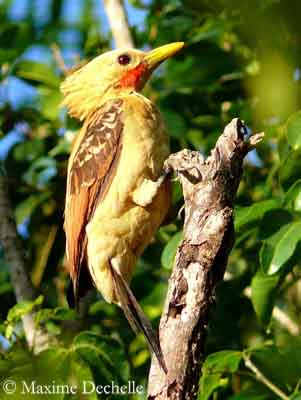
Cream-coloured Woodpecker
Celeus flavus
Piciforme Order – Picidae Family
BIOMETRICS:
Length: 24-26 cm; Weight: 95-130 g
DESCRIPTION:
This beautiful creamy-yellow woodpecker is native to South America and resident in its range. The nominate race presents very variable coloration in plumage, with wide degree of individual variation.

Cream-coloured Woodpecker adult male has pale creamy-yellow plumage, from buff-yellow to sulphur-yellow. Some brown feathers can be present on head and back.
On the wings, colour is variable. Usually, wings are dusky, with brown bases, but sometimes with more brown or rufous-brown. Flight feathers are darker, mostly brown. Upper coverts can be edged yellow, and inner flight feathers can be rufous.
Rump is pale creamy-yellow. Upper tail is blackish.
Underparts are pale creamy-yellow. The under wing is mostly brownish, with creamy-buff coverts. Undertail coverts are pale creamy-yellow, whereas undertail feathers are dark brownish.
HABITAT:
Cream-coloured Woodpecker lives mainly in swamp forests, also in swampy second growth woodlands and edges, gallery forests, mangroves and várzea, which is a forest close to rivers and flooded during several months every year. It is also found in other habitats such as cacao plantations, from lowlands up to about 400 to 700 metres of elevation.
RANGE:
Cream-coloured Woodpecker is native to South America, from Colombia and the Guianas, to Peru, Bolivia and eastern Brazil, including the southeast coastal strip.
BEHAVIOUR:
Cream-coloured Woodpecker feeds mainly on ants and termites, and also fruits and seeds. It can be seen foraging singly, but it is often in pairs or in small groups of three or four birds. This woodpecker usually forages low in trees or at medium height, but sometimes it reaches the canopy.
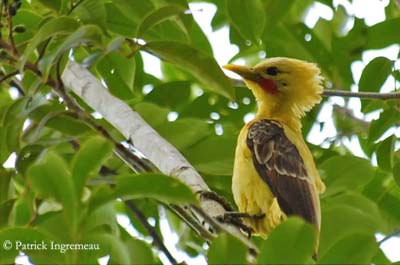
PROTECTION / THREATS / STATUS:
Cream-coloured Woodpecker is not globally threatened. It is more or less common according to the region.
Fr: Pic jaune
All : Strohspecht
Esp : Carpintero Amarillo
Ital : Picchio giallo
Nd : Strogele Specht
Photographers:
Maxime Dechelle
His website: LEPAPARRAZO
Patrick Ingremeau
His website: TAMANDUA
Marc Chrétien
His website :
MURINUS
Texte de Nicole Bouglouan
Sources :
HANDBOOK OF THE BIRDS OF THE WORLD Vol. 7 by Josep del Hoyo-Andrew Elliott-Jordi Sargatal – Lynx Edicions – ISBN: 8487334377
A GUIDE TO THE BIRDS OF COLOMBIA by Steven L. Hilty and William L. Brown
Princeton University Press – ISBN 069108372X
VOICE: SOUNDS BY XENO-CANTO
Cream-coloured Woodpecker utters typical loud, sharp “whaa-jer”. This call may be repeated several times in rapid series, and by several birds. We can also hear a loud clear “pueer, pueer, purr, paw” with descending last two notes.
Its usual call is a distinctive high-pitched laugh. Its drumming is relatively strong and helps to localize the bird.
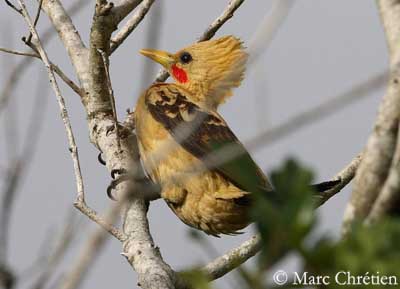
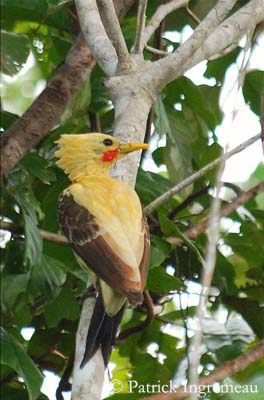
FLIGHT:
Creamy-coloured Woodpecker, as most of woodpeckers, performs undulating flight, with series of rapid wing beats and brief glides on closed wings that produces a characteristic bounding flight.
REPRODUCTION:
Breeding season occurs from April to June in Colombia, maybe earlier in Venezuela.
Nesting behaviour is unknown, but Cream-coloured Woodpecker probably nests in cavities, in holes in trees.
DIET:
Cream-coloured Woodpecker feeds mainly on ants and termites, breaking out the nest of the ants.
It also consumes fruits and seeds, which are good food supply.
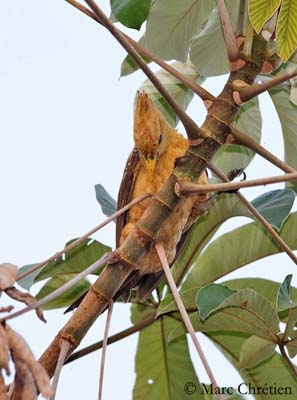
Female is similar, but she lacks the red malar stripe.
Juvenile resemble adults, but its plumage is slightly cinnamon-buff. We can see some barring on tertials. Young male shows very soon red tips on cheek feathers.
We can find four subspecies within the range:
Celeus flavus flavus.
Celeus flavus peruvianus, slightly larger, with more brown in wings than nominate.
Celeus flavus tectricialis, similar in size, with much brown in wing coverts and paler flight feathers.
Celeus flavus subflavus is largest, with broad bases and centres in feathers on mantle and breast.